From cold, high-desert mountains in the north to subtropical desert lowlands in the south, Arizona presents a variety of discrete desert ecosystems, each providing habitat for numerous species of cacti (Cactaceae or cactus family). The native cacti of Arizona vary greatly in appearance, yet each evolved similar features to thrive within the harsh environment, including water-retentive tissue, defensive spines and efficient root systems.
1. Violet Prickly Pear
Video of the Day
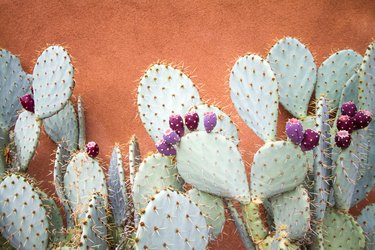
Named for the purplish-pink color of its pads, violet prickly pear (Opuntia gosseliniana var. santa-rita, USDA zones 9-11) appears in south-central Arizona, particularly in the arid, lowland regions of Pima County. Like most varieties of prickly pear, it has a spreading shrub-like habit and forms spine-covered, paddle-like foliage.
Video of the Day
It grows to between 2 and 6 feet in height with a 6-foot spread. Originally thought to be a reaction to environmental stress, the violet coloration of this species is, in fact, a defensive mechanism used to dissuade grazing animals from feeding upon it.
2. The Iconic Saguaro
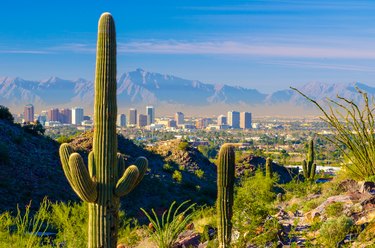
Known for its tall, branching shape, the saguaro cactus (Carnegiea gigantea, zones 9-10) is a true icon of the Arizona desert. Reaching between 15 and 50 feet in height, saguaros grow very slowly, sending up a single, 2-foot-wide column lined with clusters of 2-inch-long spines in youth.
It is only at 50 years of age that saguaros begin to produce their characteristic arms; as many as five may be produced within a plant's lifetime. Despite their great height, this species develops a relatively shallow root system, sending down a 3-foot-long tap root and numerous branching capillary roots to provide anchorage in the rocky soil.
3. Golden Hedgehog Cactus
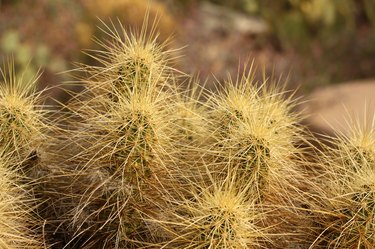
Golden hedgehog cactus (Echinocereus nicholii, zones 10-11) occurs in northern Mexico and southern Arizona, primarily within Pima County. Named for its pale-yellow spines, golden hedgehog cactus is a small, spreading species comprised of up to 20 2-foot-tall stems lined with exceptionally thick, 3-inch-long spines arranged in rosette patterns.
Due to the density of its spines, the pale-green flesh of this species is not easily seen except in young plants. In mid-spring, golden hedgehog cactus bears a crop of waxy lavender or crimson flowers, which later mature into small, red fruit.
4. Arizona Barrel Cactus
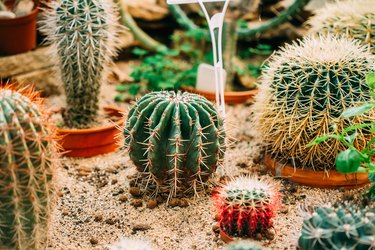
Native to the Sonoran desert, Arizona barrel cactus (Ferocactus wislizeni, zones 9-11) has spread throughout the southwestern United States. Named for its thick, round form, this species grows to between 3 and 10 feet in height with a 24-inch diameter at maturity. The flesh of Arizona barrel cactus is deeply ribbed and olive-green in color, with clusters of hooked spines lining its ribs.
It occurs in areas of periodic flooding, where it can easily absorb and store available moisture for use during drought seasons. In midsummer, Arizona barrel cacti produce several reddish-orange flowers on their southeastern sides, which are a preferred source of nectar for pollinating insects such as cactus bees.
5. Teddy Bear Cholla
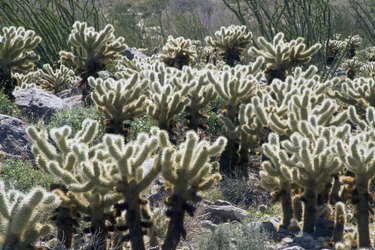
Teddy bear cholla (Cylindropuntia bigelovii, zones 9-11) earned its common name due to its fuzzy appearance. Its downy covering of dense spines is not soft to the touch like its namesake, however. Found in low desert flatlands throughout the American Southwest, teddy bear cholla thrives in rocky, well-draining soil at elevations below 300 feet in Arizona.
It is an erect, single-trunked species with numerous curving branches covered in silvery-white spines. The uppermost branches of teddy bear cholla typically appear light-beige in color with the trunk and lower branches having a reddish-brown or bronze coloration. From late April until June, it bears 4-inch-wide chartreuse flowers on the tips of its branches, which are attractive to nectar-feeding birds and insects.
- USDA Fire Effects Information System: Carnegiea gigantea
- Lady Bird Johnson Wildflower Center: Echinocereus nicholii
- Lady Bird Johnson Wildflower Center: Opuntia gosseliniana
- Lady Bird Johnson Wildflower Center: Ferocactus wislizeni
- USDA Natural Resources Conservation Service: Cylindropuntia bigelovii
- AZ Golf Homes: Identifying Common Arizona Cacti: Prickly Pear, Saguaro, Jumping Cholla and More
